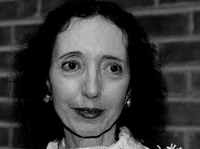Blonde
Joyce Carol Oates. Ecco, $27.5 (737pp) ISBN 978-0-06-019607-3
Dramatic, provocative and unsettlingly suggestive, Blonde is as much a bombshell as its protagonist, the legendary Marilyn Monroe. Writing in highly charged, impressionistic prose, Oates creates a striking and poignant portrait of the mythic star and the society that made and failed her. In a five-part narrative corresponding to the stages of Monroe's life, Oates renders the squalid circumstances of Norma Jeane's upbringing: the damage inflicted by a psychotic mother and the absence of an unknown (and perpetually yearned for) father, and the desolation of four years in an orphanage and betrayal in a foster home. She reviews the young Monroe's rocky road to stardom, involving sexual favors to studio chiefs who thought her sluttish, untalented and stupid, while they reaped millions from her movies; she conveys the essence of Monroe's three marriages and credibly establishes Monroe's insatiable need for security and love. To a remarkable extent, she captures Monroe's breathy voice and vulnerable stutter, and the almost schizoid personality that produced her mercurial behavior. (Emotionally volatile, fey, self-absorbed, and frightened, Monroe could also be tough, outspoken, vulgar--her notorious perfectionism a shield against the ridicule and failure that Oates claims she continually feared.) As Oates demonstrated early in her career in Them, and in many books since, she has an impressive ability to empathize with people in the underclass, and her nuanced portrait of ""MM"" carries psychological truth. Oates sees Monroe as doomed from the beginning by heredity and fate, and hurried to her death by a combination of cynical Hollywood exploitation, dependence on drugs and flawed choices of lovers and mates: JFK's cruel manipulation and shadowy intervention is the final blow to her fragile ego and her very existence. It is no surprise when, at the end, Oates subscribes to a controversial theory about Monroe's demise. Meanwhile, she draws a sharp-eyed picture of Hollywood during the 1940s and `50s; introduces a cast of movie-town personalities, from actors and agents to producers, directors and studio heads; creates intriguing character sketches of Joe DiMaggio and Arthur Miller; and conveys a nation's fascination with a cultural icon. The inevitable drawbacks in a book of this sort--deliberate omission of events, imaginative reconstruction of public and other events from Monroe's point of view--are problematical but not crucial. In an author's note, Oates declares that her novel ""is not intended as a historic document."" Yet she illuminates the source of her subject's long emotional torment as few factual biographies ever do. 100,000 first printing; major ad/promo; Literary Guild alternate; simultaneous Harper Audio; 5-city author tour. (Apr.)
Details
Reviewed on: 04/03/2000
Genre: Fiction
Downloadable Audio - 752 pages - 978-0-06-081441-0
Hardcover - 992 pages - 978-2-234-06469-0
Other - 752 pages - 978-0-06-268586-5
Paperback - 768 pages - 978-0-06-296845-6
Paperback - 752 pages - 978-0-06-093493-4
Paperback - 752 pages - 978-0-06-177435-5
Paperback - 1115 pages - 978-2-253-15285-9
Paperback - 933 pages - 978-607-11-1856-1



